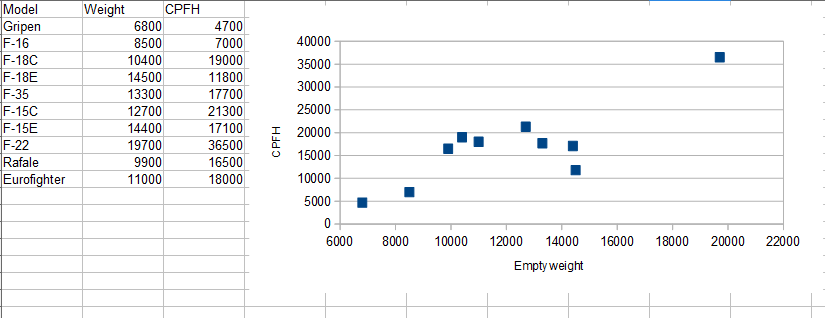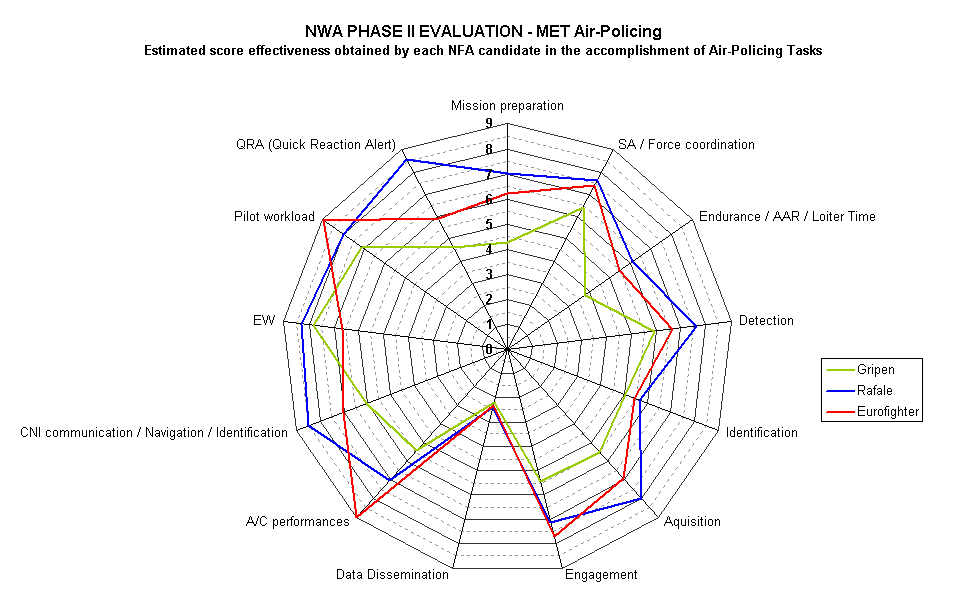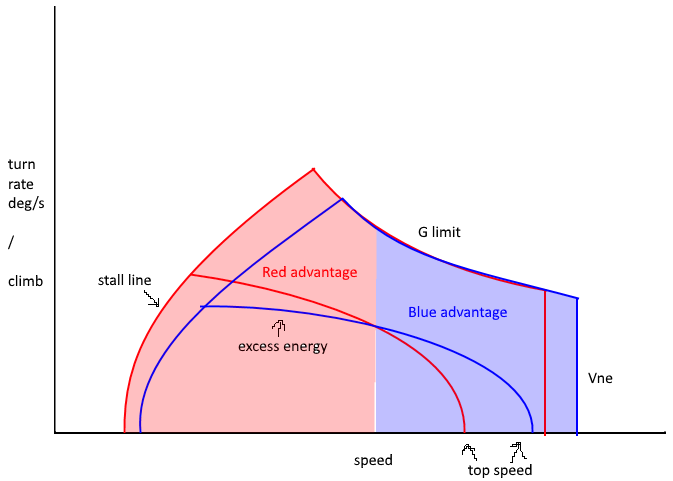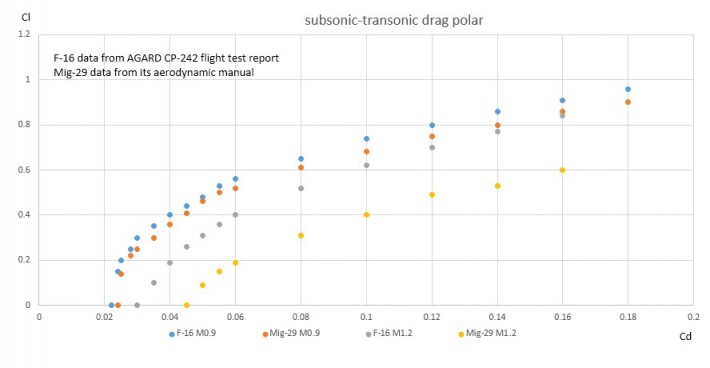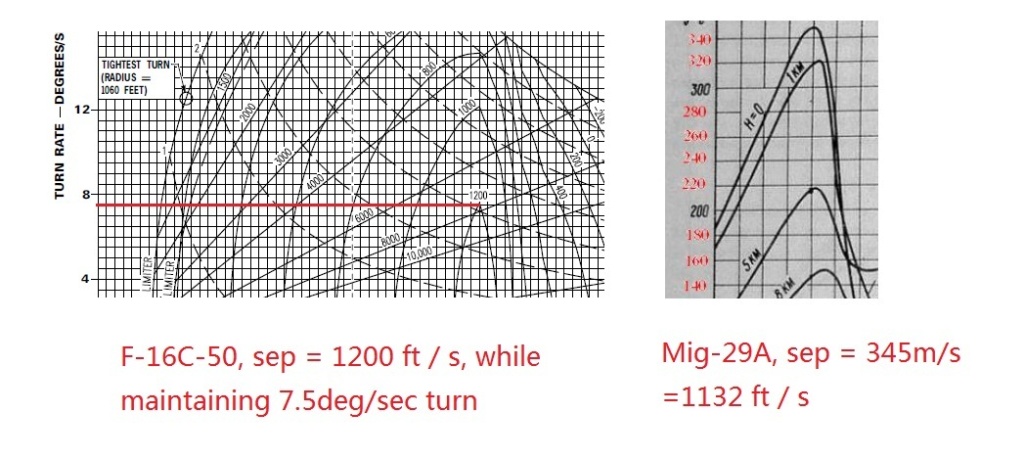If you can buy and maintain two or three for the price of one of the others it would still be an attractive plane.
Yes, because having lots of planes is always more effective than having good planes... that is why the Soviets won WWII because they had more Polikarpovs than the rest of the world combined had aircraft.... and it was the same with light tanks... they Soviets had tens of thousands of T-26 light tanks so of course they won WWII, because small cramped two man tanks with poor optics, a good gun, weak armour and no communications is always going to kick the arse of much smaller numbers of German tanks with ordinary guns, ordinary armour, good optics and well laid out crew roles and tactics and excellent communications and training...
I think it is fairly reasonable to think a small, light plane with little dead weight (small airframe and fuel tanks) has some advantage in manoeuvrability and acceleration, also visual footprint is relevant in combat. But the diagram does not explain much in that regard.
The problem there is that both sides had already adopted air defence systems that largely involved large radars being used to detect threats and command structures where interceptors were directed to engage those threats along paths that were the safest for those interceptors to positions where the interceptors could launch attacks on the targets at minimal danger to themselves... directed by AWACS or ground control... where acceleration and manouver don't really come in to it.
By the mid 1990s HATO had had their chance to practise against MiG-29s and R-73s and helmet mounted sights and they realised that dogfighting with the Soviets would be suicide and that launching longer ranged missiles from outside visual range was the way to go because if you got within visual range of the target then that was mutual and if they launched a missile at you before your missile took them out of the fight then there was a good chance you were both walking home... if you survived that is.
Manouver became Typhoon manouver... climb and accelerate and launch and then turn away... old model Sidewinders and their equivalents had narrow fields of view and slow tracking rates and could not turn particularly hard... R-73s and similar later missiles had wide fields of view and fast tracking rates and thrust vectoring engines so they could turn hard and follow even light fighters turning in eye watering turns...
As I mentioned the F-16s they tested against the downgraded export MiG-29Bs used by East Germany that were further lumbered with having to carry the centreline external fuel tank which reduced manouver performance (5g I seem to remember) managed to get on the tails for a shot about 62% of the time... but they didn't win any of the tests because the MiG-29 pilot was ruled in each case to have already taken a shot with their high offboresight R-73s and gotten a kill before the F-16 was ready to fire.
I am not trying to suggest manouver is of no use, but during WWI the game was to get on the targets tail to prevent your enemy from bringing to bare his forward firing guns on you while at the same time positioning your forward firing guns on him... the ideal situation... if your aircraft was more agile than his there are not many manouvers he can perform to get you off his tail... which makes his position dominant.
Right now however, a missile can manouver and cover distance much faster than a plane... so being able to fire a missile forward that turns 180 degrees and comes back at something behind you means your position isn't as dominant... and more importantly pulling back hard on the flight stick to rotate the nose of the aircraft up and over and to end up pointing backwards and then launching a missile that missile will burn all its energy accelerating towards the enemy plane and wont be wasting energy pulling a 180 degree turn in the first few seconds of its flight... the time when it has the most energy it is wasting it on a hard turn...
In WWI such a manouver would be suicide because you can't fire guns forward and have the bullets turn 180 degrees and hit a target behind you, and pulling back on the stick to face backwards would result in a super stall which would make you an easy stationary target and then you would fall uncontrollably... so you stop and drop with no control of where you guns are facing.
Today with thrust vector control engines you can turn your nose to point at the target and keep it there to launch a missile and then point your nose down and fly away in full control.... you will be a stationary target but if you do it when the enemy is 5km away on your tail, your missile should hit him before he gets in cannon range anyway, and you will be directing your nose at the next target to launch a missile at anyway.
The rules of maintaining energy are changed because you don't stall and lose control of your weapons...
If Jane's values are true and Gripen costs 5 k to operate vs 18 k on the Eurofighter for instance, then the whole argument "which is better" is pointless.
But the Eurofighter was never intended as a cheap to operate aircraft so the example is irrelevant... but even if we ignore that... if it takes three Gripens to get the job done then is it really cheaper in actual terms because owning and operating three times more aircraft is not really actually saving much money...
Why are you trying to make this a matter of black or white? You know aircraft design is a matter of compromising. I stated some natural consequences of the single vs twin engine on the general shape and characteristics of the airframe, not claimed one to be superior above the other.
Because you are demanding that the new stealth MiG be single engined because you claim it would make it cheaper aren't you?
- If you have twin engines side by side, you place mass and drag in parallel with the planes longitudinal axis, since two engines are wider and shorter than one of the same thrust. Agree?
I would agree but would argue if the single engine has the same thrust as the two engines in a twin then you have already lost because that single is going to be crap.
To even have a chance of being useful the single has to have at least 3/4ths the power of the two engines combined.... ie MiG-29 with two 8 ton thrust engines vs F-16 with an 8 ton thrust engine? More like 12 ton at the very least...
- You get more drag for the same thrust with that design, but also a shorter airframe that may be lighter and hence have some other advantages associated to it, like lower pitch moment.
Spaced engines also add fuselage lift and torque for roll control using TVC engines... and space for internal weapon bays...
Here it is easy to understand why a fighter like the MiG-29 has a short and wide fuselage, high TWR and low fuel. It was designed for being capable to keep up or defeat F-16 and F-15 in close combat. Its design characteristics were not specially good for range. In combat, it has worse energy conservation than the F-16, which is also easy to infer from both plane's design characteristics and fully consistent with the data I provided. Each approach has its pros and cons.
Every upgrade the MiG has ever had has included improvements in fuel capacity... but I wonder if the F-16 and F-15 are so fuel rich why are both getting conformal external fuel added to their designs?
- Economies of scale and ease of maintenance due to the fact that both aircraft share the same engine;
It is a false economy, because the heavy and light fighters will rarely operate together from the same base so commonality is irrelevant except at the strategic level where having a couple of different engine types is fine... for goodness sake at the moment the Su-27SM, Su-30, Su-34, Su-35, and Su-57 don't use the same engine... it is clearly not critical.
- Complementarity between the characteristics of those two planes: one should have long range, big payload and powerful systems & avionics while the other should be very agile, simple, cheap to operate and numerous.
They can already achieve that with the Su-57 and the S-70 drone combination...
One would control the BVR combat while the other would be a plane the enemy does not want to meet at close quarters.
With modern WVR missiles no one wants to meet at close quarters...
They could fit a Yak-152 with 10 weapon pylons and a helmet mounted sight... it would be smaller than any F-16 or MiG-21... it would be cheap...
They should be full blown heavy fighters, not half arsed hopeless attempts at making a big plane that costs like a small one.
You are the one suggesting that fitting one engine to an otherwise modern fighter will somehow make it cheap and simple.
It is pretty clear the Russians are not interested as they have already stated it will be a twin...
In the case of the new MiG-29 generation, they were so nice not to publish empty weights. That is the crucial data they can hide and difficult all the comparative analysis, because it influences everything, wing load, STR, acceleration, climb, fuel consumption and so on.
They are not obliged to reveal anything at all, but I don't understand why you think a plane with better wing load or STR or acceleration or climb rate or fuel consumption and so on makes any difference at all... the MiG-21 was one of the best examples of light fighters... small light cheap easy to operate and maintain, difficult to see in combat... according to you it would be the ideal replacement for the MiG-29... except it isn't... the MiG-21 design is great for size and cost, but its limit payload and range means you can have a lot, but you need a lot, and in most areas the F-16 is better simply because the MiG-21 was the benchmark that the F-16 design was based on, but that is not to say it can beat every time unless the F-16 has AMRAAMs and the MiG-21 has AA-2s...
The reality is that the air force that operates the aircraft and the missiles it will be carrying and of course training and tactics matter more than fuel efficiency.
I can provide also info on that, as well as comments from the pilots dealing with the details of the engagements. In short, in WVR the helmet and missile combo was far superior, not the manoeuvrability or dynamic performance of the plane.
So as new aircraft will be fitted with WVR missiles and helmet mounted sights doesn't that render agility less useful than altitude and speed?
Makes a lot of sense, if they felt they had a better BVR package but were not superior in close combat.
They didn't, but they didn't appreciate that either...
As to the costs of the MiG, the reality is that we don't know them, and their leadership's sales pitch "our MiG-35 is twice and a half times cheaper than the MiG-29" doesn't help either.
And who do you think they are fooling... the Russian Air Force know what their MiG-29s cost to operate and they know the costs of operating Flankers of all types too.
The relevant question is: how much cheaper the MiG-29 would be, if it was single engine? That I would really like to know. Don't you think the reduced maintenance and spare parts burden would help, even when not discussing how relevant in the total CPFH that would be?
Klimov doesn't have a suitable engine, it would be a pointless exercise... a bit like saying what sort of performance would a MiG-31 have if you take out the two jet engines it has and replace them with a single NK-32 25 ton thrust engine... being a single engined aircraft they could make it so much lighter so the loss of power with the single engine could be compensated by lower drag blah blah blah...
Or how about a twin engined B-52... wouldn't it be so much cheaper and simpler... they could double its range...
The problem is that the Russian Air Force is not interested in manned single engined fighters... as far as I can tell the only single engined aircraft they have are trainers.... Yak-152, L39, and the An-2 transport plane...
Of course. It is also very easy to falsify data for political gain, like when they talk big now about the availability rates of the F-35, without saying how much does it cost to keep them above 80%. I can have 100 guys nursing every plane at an astronomical cost and the warehouse full of pieces that are missing somewhere else, as far as such information is not publicised everything seems ok.
Not new... during Desert Storm there were issues with the availability rates of the Apache helicopters.... the solution was pretty simple... they tripled the budget and man hours in maintenance and the availability rates got close to normal...
BTW: I didn't realize when creating this thread, that Stealthflanker had already done one. Can we merge both?
Make it easier for me with a link....







